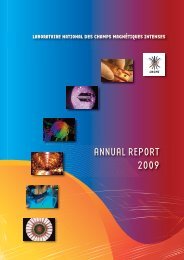Laboratoire National des Champs Magnétiques Pulsés CNRS – INSA
Laboratoire National des Champs Magnétiques Pulsés CNRS – INSA
Laboratoire National des Champs Magnétiques Pulsés CNRS – INSA
Create successful ePaper yourself
Turn your PDF publications into a flip-book with our unique Google optimized e-Paper software.
Research Council (“Opportunities in High Magnetic Field Sciences”, COHMAG 2005), a compelling<br />
case has been made for high magnetic fields as a research tool for a wide variety of research topics and<br />
strong recommendations were made to stimulate high magnetic field large facilities.<br />
Since then, the recent developments in high magnetic field science have only further emphasised the<br />
importance and impact of high magnetic fields. The results obtained clearly illustrate the power,<br />
versatility and necessity of high magnetic fields as a research tool.<br />
<strong>National</strong> and international context<br />
The generation of very high magnetic fields is a technological challenge and their exploitation requires<br />
a high financial commitment. Therefore not many infrastructures exist where very high magnetic<br />
fields can be generated and used for research. Over the last twenty years, financial limitations and the<br />
complexity of such installations have resulted in a further concentration of these activities in less but<br />
larger infrastructures, very often operated on a national scale. For generating continuous magnetic<br />
fields in excess of 30 T, powered with 15+ MW power supplies, installations can be found in the USA<br />
(Tallahassee), Japan (Tsukuba) and Europe (Grenoble and Nijmegen). Large pulsed field installations<br />
based either on motor generators or large (> 5 MJ) capacitor banks are found in Los Alamos (USA),<br />
Tokyo (Japan), and in Europe in Toulouse and in Dresden (created in 2006). As the most recent step in<br />
this trend, in 2007 the Chinese government has created a 40 M€national high magnetic field facility,<br />
consisting of a static field installation in Heifei and a pulsed field installation in Wuhan. Still the<br />
clearest example of this trend is the creation of the <strong>National</strong> High Magnetic Field Laboratory<br />
(NHMFL) in the USA, a three site organization that pioneers all aspects of high magnetic field<br />
generation, and its use for scientific experiments.<br />
The current LNCMP installation was <strong>des</strong>igned in 1992, and completed in 2000. Despite the continuous<br />
and gradual improvements that have been implemented since then, this installation is basically no<br />
longer up to the current standards and major investments are needed to improve its safety and to<br />
guarantee its international competitiveness in the future. To obtain the necessary investments, it is<br />
necessary to increase the weight and impact of high magnetic fields within the context of the French<br />
large facilities. Following the example of the NHMFL, it was therefore proposed to merge the LCMI<br />
and LNCMP into one <strong>Laboratoire</strong> <strong>National</strong> <strong>des</strong> <strong>Champs</strong> <strong>Magnétiques</strong> Intenses (LNCMI, UPR3228),<br />
on two sites. The new laboratory, with its increased size, scientific production and impact, and user<br />
community, will become a more important factor among the French large facilities, and it can be<br />
expected that through collaboration and synergy, the LNCMI will be more than just the sum of the<br />
LCMI and LNCMP, again improving the position of high field science in France and in Europe.<br />
The LNCMI is the coordinator of the FP7 European infrastructure activity ‘EuroMagNET2’<br />
(www.euromagnet2.eu) (2009-2012) that coordinates the activities of all European high field facilities<br />
(LNCMI, HLD Dresden, HFML Nijmegen). To further strengthen European collaboration, the<br />
LNCMI has been advocating the creation of a distributed European Magnetic Field Laboratory,<br />
uniting these four installations. This idea has been implemented through an ESRFI Roadmap Update<br />
proposal that was accepted last December (www.emfl.eu) and that will be elaborated in a future FP7<br />
<strong>des</strong>ign study.<br />
4







